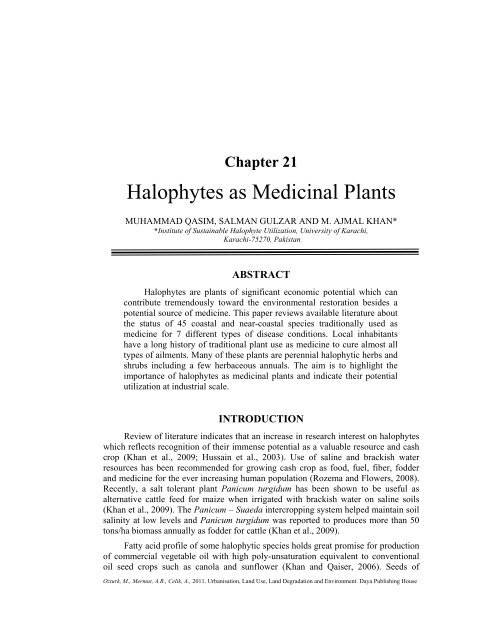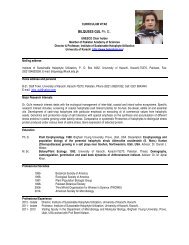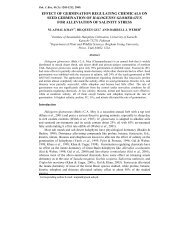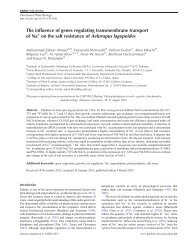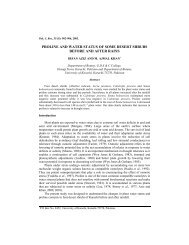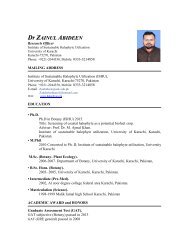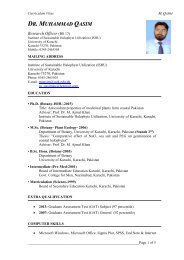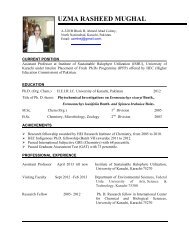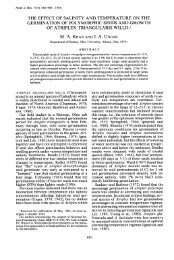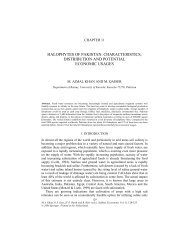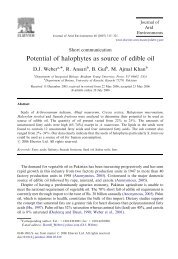Halophytes as Medicinal Plants - ResearchGate
Halophytes as Medicinal Plants - ResearchGate
Halophytes as Medicinal Plants - ResearchGate
You also want an ePaper? Increase the reach of your titles
YUMPU automatically turns print PDFs into web optimized ePapers that Google loves.
Chapter 21<br />
<strong>Halophytes</strong> <strong>as</strong> <strong>Medicinal</strong> <strong>Plants</strong><br />
MUHAMMAD QASIM, SALMAN GULZAR AND M. AJMAL KHAN*<br />
*Institute of Sustainable Halophyte Utilization, University of Karachi,<br />
Karachi-75270, Pakistan<br />
ABSTRACT<br />
<strong>Halophytes</strong> are plants of significant economic potential which can<br />
contribute tremendously toward the environmental restoration besides a<br />
potential source of medicine. This paper reviews available literature about<br />
the status of 45 co<strong>as</strong>tal and near-co<strong>as</strong>tal species traditionally used <strong>as</strong><br />
medicine for 7 different types of dise<strong>as</strong>e conditions. Local inhabitants<br />
have a long history of traditional plant use <strong>as</strong> medicine to cure almost all<br />
types of ailments. Many of these plants are perennial halophytic herbs and<br />
shrubs including a few herbaceous annuals. The aim is to highlight the<br />
importance of halophytes <strong>as</strong> medicinal plants and indicate their potential<br />
utilization at industrial scale.<br />
INTRODUCTION<br />
Review of literature indicates that an incre<strong>as</strong>e in research interest on halophytes<br />
which reflects recognition of their immense potential <strong>as</strong> a valuable resource and c<strong>as</strong>h<br />
crop (Khan et al., 2009; Hussain et al., 2003). Use of saline and brackish water<br />
resources h<strong>as</strong> been recommended for growing c<strong>as</strong>h crop <strong>as</strong> food, fuel, fiber, fodder<br />
and medicine for the ever incre<strong>as</strong>ing human population (Rozema and Flowers, 2008).<br />
Recently, a salt tolerant plant Panicum turgidum h<strong>as</strong> been shown to be useful <strong>as</strong><br />
alternative cattle feed for maize when irrigated with brackish water on saline soils<br />
(Khan et al., 2009). The Panicum – Suaeda intercropping system helped maintain soil<br />
salinity at low levels and Panicum turgidum w<strong>as</strong> reported to produces more than 50<br />
tons/ha biom<strong>as</strong>s annually <strong>as</strong> fodder for cattle (Khan et al., 2009).<br />
Fatty acid profile of some halophytic species holds great promise for production<br />
of commercial vegetable oil with high poly-unsaturation equivalent to conventional<br />
oil seed crops such <strong>as</strong> canola and sunflower (Khan and Qaiser, 2006). Seeds of<br />
Ozturk, M., Mermut, A.R., Celik, A., 2011. Urbanisation, Land Use, Land Degradation and Environment. Daya Publishing House
<strong>Halophytes</strong> <strong>as</strong> <strong>Medicinal</strong> <strong>Plants</strong> 331<br />
various halophytes, such <strong>as</strong> Suaeda fruticosa, Arthrocnemum macrostachyum,<br />
Salicornia bigelovii, S. brachiata, Halogeton glomeratus, Kochia scoparia, and<br />
Haloxylon stocksii possess a sufficient quantity of high quality edible oil with<br />
unsaturation ranging from 70-80 % (Weber et al., 2001). Shoots of Salicornia<br />
bigellovi, Sesuvium portulac<strong>as</strong>trum, Chenopodium album, Portulaca oleracea, and<br />
Suaeda maritima are used for vegetables, salads and pickles in various parts of the<br />
country. Fuel wood is also traditionally obtained from salt tolerant perennials such <strong>as</strong><br />
Prosopis, Tamarix, Salsola, Acacia, Suaeda, Kochia, Capparis and Salvadora (Dagar,<br />
1995).<br />
Khan and Qaiser (2006) reported more than 400 species of halophytes in<br />
Pakistan with almost 100 species or 1/4 of the total number from co<strong>as</strong>tal are<strong>as</strong>. Most<br />
of the halophytes of arid are<strong>as</strong> are perennial shrubs or perennial herbs which can<br />
provide a sustainable supply of plant material from multiple harvests using nonconventional<br />
saline irrigation system on poor quality soil and brackish water<br />
irrigation. With appropriate management and monitoring, saline irrigation and<br />
cropping systems hold great promise for tapping the highly productive saline systems<br />
for meeting the b<strong>as</strong>ic needs of local communities and also for ensuring high economic<br />
returns in salt prone are<strong>as</strong>.<br />
This paper is a brief review of the medicinal importance of co<strong>as</strong>tal halophytic<br />
species along the Arabian Sea co<strong>as</strong>t which are reported for their use in treating a<br />
number of ailments in local communities (Table 1). The information will help us to<br />
find patterns of plant use and their relationship with other human community<br />
attributes that binds man and nature together.<br />
CURRENT SALINITY SCENARIO<br />
Good quality land and fresh water need to be utilized primarily for growing food<br />
for the ever growing population. However, immense potential lies not only in<br />
reclamation of salinized lands by improving soil fertility but also in better utilization<br />
of these untapped resources for cultivating non-conventional salt tolerant c<strong>as</strong>h crop<br />
plants – the <strong>Halophytes</strong>. About 6.5 million hectares of land are salt affected out of<br />
which approximately 2 million hectares are slightly to moderately affected but these<br />
can successfully be utilized to produce medicinal plants besides other uses.<br />
The consumption of medicinal herbs in Pakistan w<strong>as</strong> estimated at 631.5 tons<br />
worth about Rs. 1.5 billion annually (Hussain et al. 2003). However, 90% of these<br />
herbs are imported from countries like Sri Lanka, China and India which grow a<br />
variety of medicinal plants for local use <strong>as</strong> well <strong>as</strong> for export to neighboring countries<br />
and earn considerable foreign exchange. Pakistan lacks the b<strong>as</strong>ic infr<strong>as</strong>tructure to<br />
efficiently exploit the full potential of naturally growing herbs even for domestic<br />
usages while there is a constant decre<strong>as</strong>e in indigenous plant species biodiversity due<br />
to both urbanization <strong>as</strong> well <strong>as</strong> global climate changes (IUCN, 2004). Concerted<br />
research efforts are required to domesticate indigenous medicinal plants to be used <strong>as</strong><br />
c<strong>as</strong>h crops on an urgent b<strong>as</strong>is.
Table 21.1 – Contd…<br />
332 Urbanisation , Land Use, Land Degradation and Environment<br />
S # Name of species (Family) Habit Life<br />
form<br />
Table 21.1: Traditional uses of halophytes reported <strong>as</strong> medicine<br />
Part<br />
used<br />
Preparation <strong>Medicinal</strong> use Reference<br />
1 Acacia nilotica L. (Mimosaceae) T P L,B,G Decoction Asthma, diarrhea, demulcent Ilahi, 2008<br />
2 Achyranthes <strong>as</strong>pera L.<br />
(Amaranthaceae)<br />
3 Aerva javanica (Burm. f.) Juss. ex<br />
J.A. Schultes (Amranthaceae)<br />
H P R Powder Asthma, cough, pneumonia, joint pain, labor<br />
discomfort<br />
Sh P L,F,WP P<strong>as</strong>te/<br />
Decoction<br />
Wounds, Jaundice, Diabetes, cough,<br />
headaches<br />
Qureshi & Bhatti, 2008; Savithramma et<br />
al., 2007<br />
Qureshi & Bhatti, 2008,<br />
Hammiche & Maiza, 2006<br />
4 Alhagi maurorum Medic. (Fabaceae) Sh P WP Decoction Laxative, diuretic, eye infections Ilahi, 2008; Goodman & Ghafoor, 1992<br />
5 Amaranthus virdis L.<br />
(Amaranthaceae)<br />
6 Arthrocnemum indicum (Willd.)<br />
Moq (Chenopodiaceae)<br />
7 Atriplex stocksii Boiss<br />
(Chenopodiaceae)<br />
8 Calotropis procera (Ait.) Ait. f.<br />
(Asclepidaceae)<br />
9 Capparis decidua Forssk.<br />
(Capparidaceae)<br />
10 Chenopodium album L.<br />
(Chenopodiaceae)<br />
11 Citrullus colocynthis L.<br />
(Cucurbitaceae)<br />
12 Cleome brachycarpa Vahl.<br />
(Capparidaceae)<br />
H A WP Potherb Constipation, gall bladder/kidney stones Qureshi & Bhatti, 2008<br />
Sh P WP Ashes Alexipharmic Agoramoorthy, 2008<br />
Sh P L, WP Infusion Fever, jaundice, dropsy, liver dise<strong>as</strong>e Qureshi et al., 2009<br />
Sh P WP P<strong>as</strong>te Tooth & stomach aches Ilahi, 2008<br />
Sh P F, B Decoction Carminative, aphrodisiac, ulcer, cough,<br />
<strong>as</strong>thma, stomach aches<br />
Ilahi, 2008; Goodman & Ghafoor, 1992<br />
H A WP Potherb Constipation Qureshi & Bhatti, 2008<br />
H P F, R Toothache,<br />
Pills,<br />
H A WP With sesame<br />
oil<br />
Toothache, Constipation, bleeding, piles,<br />
diabetes, leucorrhea, Asthma<br />
Itching, Joint pain, skin dise<strong>as</strong>es,<br />
inflammation<br />
Goodman & Ghafoor, 1992; Qureshi &<br />
Bhatti, 2008; Savithramma et al. 2007<br />
Qureshi & Bhatti 2008;<br />
Contd…
Table 21.1 – Contd…<br />
<strong>Halophytes</strong> <strong>as</strong> <strong>Medicinal</strong> <strong>Plants</strong> 333<br />
S # Name of species (Family) Habit Life<br />
form<br />
Part<br />
used<br />
Preparation <strong>Medicinal</strong> use Reference<br />
Shafi et al., 2001<br />
13 Cleome viscosa L. (Capparidaceae) H A WP Juice Ear infection, pain, deafness Qureshi & Bhatti, 2008<br />
14 Corchorus depressus (L.) Stocks<br />
(Tiliaceae)<br />
Sh P WP Infusion Dysuria Goodman & Ghafoor, 1992<br />
15 Cressa cretica L. (Convolvulaceae) H p L P<strong>as</strong>te Sores Qureshi & Bhatti, 2008<br />
16 Cymbopogon jwarancusa Boiss.<br />
(Poaceae)<br />
17 Cynodon dactylon (L.) Pers.<br />
(Poaceae)<br />
G P WP Decoction Fever, catarrh, joint pain, inflammation Qureshi & Bhatti, 2008; Goodman &<br />
Ghafoor, 1992<br />
G P WP P<strong>as</strong>te Cuts, wounds Qureshi & Bhatti, 2008<br />
18 Cyperus rotundus L. (Cyeraceae) Se P R Poultice Acne, Carbuncle Qureshi & Bhatti, 2008<br />
19 Desmostachya bipinnata L.<br />
(Poaceae)<br />
20 Digera muricata (L.) Mart<br />
(Amranthaceae)<br />
21 Euphorbia caducifolia Haines<br />
(Euphorbiaceae)<br />
22 Fagonia indica Burm. f.<br />
(Zygophyllaceae)<br />
G P R Potherb Carbuncle Qureshi & Bhatti, 2008<br />
H A WP Powder Constipation Qureshi & Bhatti, 2008<br />
Sh P La Raw Incre<strong>as</strong>e male sexual vigor Goodman & Ghafoor, 1992<br />
Sh P WP Decoction Skin eruption, malarial fever Qureshi & Bhatti, 2008; Goodman &<br />
Ghafoor, 1992<br />
23 Glinus lotoides L. H A WP Powder Blood purifier Qureshi & Bhatti, 2008<br />
24 Gynandropsis gynandra (L.) Briq.<br />
(Capparidaceae)<br />
25 Haloxylon stocksii (Boiss.) Benth. &<br />
Hook. (Chenopodiaceae)<br />
H A R, L Decoction Stomach ace and skin inflammation Shafi et al., 2001<br />
Sh P WP Decoction Tooth and stomach aches Ilahi, 2008<br />
26 Heliotropium cur<strong>as</strong>savicum L. H P R P<strong>as</strong>te Boils Qureshi & Bhatti, 2008<br />
Contd…
Table 21.1 – Contd…<br />
334 Urbanisation , Land Use, Land Degradation and Environment<br />
S # Name of species (Family) Habit Life<br />
form<br />
(Boraginaceae)<br />
27 Heliotropium strigossum Willd.<br />
(Boraginaceae)<br />
28 Heliotropium. eichwaldi Steud.<br />
(Boraginaceae)<br />
29 Ipomoea pes-caprae (L.) Swt.<br />
(Convolvulaceae)<br />
30 Leuc<strong>as</strong> urticifolia (Vahl) Rr. B.<br />
(Labiatae)<br />
31 Peganum harmala L.<br />
(Zygophyllaceae)<br />
32 Portulaca oleracea L.<br />
(Portulacaceae)<br />
33 Rhizophora mangle L.<br />
(Rhizophoraceae)<br />
34 Suaeda monoica Forsk. ex Gmel.<br />
(Chenopodiaceae)<br />
35 Salvadora oleoides Decne.<br />
(Salvadoraceae)<br />
36 Salvadora persica L.<br />
(Salvadoraceae)<br />
37 Salsola imbricata Forssk.<br />
(Chenopodiaceae)<br />
38 Solanum surattense Burm.f.<br />
(Solanaceae)<br />
Part<br />
used<br />
Preparation <strong>Medicinal</strong> use Reference<br />
Sh P WP P<strong>as</strong>te Boils, Ulcer, wounds Shafi et al., 2001<br />
Sh A L Raw Earache Shafi et al., 2001<br />
H P WP Decoction Diarrhea, pains, vomiting, inflammation of<br />
legs, piles<br />
Agoramoorthy, 2008<br />
H A WP Decoction Cold, fever, g<strong>as</strong>trointestinal problems. Shafi et al., 2001<br />
H P WP,S Decoction Anti-microbial, colic, lumbago/Rheumatisms,<br />
back pains<br />
H A L,F,S Infusion Stomach ache, g<strong>as</strong>tric trouble Husain et al., 2008<br />
Sh P F,R,W Maceration,<br />
tea<br />
Diarrhea, diabetes Ferreira, 2009<br />
Ilahi 2008; Hammiche & Maiza, 2006<br />
Sh P WP P<strong>as</strong>te Ointment for wounds Agoramoorthy, 2008<br />
Sh P L,F,S Decoction Purgative, aphrodisiac, diarrhea Shafi et al. 2001; Goodman & Ghafoor,<br />
1992<br />
Sh P L,F Decoction Asthma, cough Shafi et al. 2001; Savithramma<br />
et al. 2007<br />
Sh P WP Infusion Insecticidal, V<strong>as</strong>cular hypertension H<strong>as</strong>san et al 2005, Hammiche & Maiza,<br />
2006<br />
Sh P F, WP Pills Bronchial, <strong>as</strong>thma, headache, cough, joint<br />
pain And chest pain, vomiting, burning feet<br />
Qureshi and Bhatti 2008, Savithramma et<br />
al., 2007; Ilahi, 2008; Goodman &<br />
Contd…
Table 21.1 – Contd…<br />
<strong>Halophytes</strong> <strong>as</strong> <strong>Medicinal</strong> <strong>Plants</strong> 335<br />
S # Name of species (Family) Habit Life<br />
form<br />
39 Suaeda fruticosa Forssk.<br />
(Chenopodiaceae)<br />
40 Trianthema portulac<strong>as</strong>trum L.<br />
(Aizoaceae)<br />
41 Tribulus terrestris L.<br />
(Zygophyllaceae)<br />
42 Withania somnifera (L.) Dunal<br />
(Solanaceae)<br />
43 Zaleya pentandra (L.) Jeffrey in<br />
Kew Bull (Aizoaceae)<br />
44 Ziziphus nummularia (Burm. f.)<br />
Wight & Arn. (Rhamnaceae)<br />
45 Zygophyllum simplex L.<br />
(Zygophyllaceae)<br />
Part<br />
used<br />
Sh P L Water and<br />
Alcoholic<br />
extracts<br />
Preparation <strong>Medicinal</strong> use Reference<br />
Ghafoor, 1992<br />
Antibacterial R<strong>as</strong>heed et al., 2000<br />
H A L Decoction Asthma Qureshi et al 2009; Savithramma et al.,<br />
2007<br />
H A R Infusion Urinary calculi, spermatorrhoea, general<br />
debility, Asthma, Kidney stones<br />
Sh P F, L Decoction Anthelmintic, leucorrhoea, tuberculosis Hussain et al., 2008<br />
Qureshi & Bhatti, 2008; Savithramma et<br />
al., 2007; Hammiche and Maiza 2006;<br />
Hussain et al 2008<br />
H P R Powder Influenza, phlegmatic cough Qureshi & Bhatti, 2008<br />
Sh P L, F, B Decoction Digestive, blood purifier, sores, skin dise<strong>as</strong>es Ilahi, 2008<br />
H A L Decoction Helminthi<strong>as</strong>es Hammiche & Maiza, 2006<br />
Key: Sh- Shrub; H- Herb; T- Tree; G- Gr<strong>as</strong>s; Se- sedge; L- Leaves; WP- Whole plant; F- Fruit; R- Root; S- Seed; B- Bark; La- Latex; A- Annual; P- Perennial.<br />
Contd…
334 336 338<br />
Urbanisation, Land Use, Land Degradation and Environment<br />
DISTRIBUTION<br />
<strong>Halophytes</strong> are found in a range of environmental conditions depending on their<br />
ability to tolerate various combinations of salts in the substrate (Song et al., 2008) and<br />
may be grouped in various ways such <strong>as</strong> into co<strong>as</strong>tal, near co<strong>as</strong>tal and inland species<br />
depending on the proximity to the open sea or according to the type of habitat they<br />
occupy such <strong>as</strong> salt desert, salt flat or salt marsh plants.<br />
RESULTS AND DISCUSSION<br />
<strong>Halophytes</strong> are adapted to tolerate harsh saline and arid conditions by<br />
synthesizing a number of active chemicals to maximize their fitness, many of which<br />
are a source of potent medicine against a number of chronic ailments. Co<strong>as</strong>tal<br />
environments were reported to be more stressful than inland due to higher soil<br />
salinity, greater light intensity and more frequent diurnal and se<strong>as</strong>onal climatic<br />
conditions (Gulzar and Khan, 1998). Numerous reports have documented the<br />
traditional uses of medicinal plants in rural and tribal are<strong>as</strong> all over the world <strong>as</strong> a<br />
successful home remedy against different ailments (Hamburger and Hostettmann,<br />
1991; Hammiche and Maiza, 2006; Hussain et al., 2006).<br />
TRADITIONAL USES<br />
The ethnobotanical data collected from different sources covers 7 health related<br />
conditions i.e., digestive, skin, respiratory, pain, fever and toothache, genito-urinary<br />
and others. A summary of the different ethnobotanical uses of 45 documented species<br />
(Table 1) and their percent distribution with respect to type of dise<strong>as</strong>e condition<br />
(Table 2) is presented here. In almost all c<strong>as</strong>es whole plants or plant parts are used <strong>as</strong><br />
a cure for various illnesses which indicates the presence of beneficial chemicals.<br />
DIGESTIVE CONDITIONS<br />
Twenty four percent of the species reported here are used <strong>as</strong> purgatives,<br />
carminatives and <strong>as</strong> anti-helmintics in the treatment of digestive disorders like<br />
stomach pain, vomiting, diarrhea (Fig 1). Acacia nilotica L., Citrullus colocynthis L.<br />
and Ipomoea pes-caprae (L.) Swt. are the most frequently used species. Chenopodium<br />
album L. and Digera muricata (L.) Mart. are used to treat constipation and bowel<br />
movement. Haloxylon stocksii (Boiss.) Benth. & Hook. and Portulaca oleracea L. are<br />
used for the treatment of stomach ache (Ilahi 2008; Husain et al. 2008), for ulcer<br />
(Ilahi 2008; Shafi et al. 2001) and for vomiting and g<strong>as</strong>tric trouble (Agoramoorthy<br />
2008, Shafi et al. 2001, Qureshi and Bhatti 2008, Savithramma et al. 2007, Ilahi<br />
2008). Capparis decidua Forssk. is a popular carminative (Ilahi 2008) while Withania<br />
somnifera (L.) Dunal and Zygophyllum simplex L. are used to cure helminthi<strong>as</strong>es<br />
(Husain et al. 2008; Hammiche and Maiza 2006). Salvadora oleoides Decne. is also<br />
used <strong>as</strong> a purgative (Shafi et al. 2001) while Rhizophora mangle L. is used to treat<br />
diarrhoea (Coelho-Ferreira 2009).<br />
SKIN CONDITIONS<br />
Skin conditions account for 15% of plant species listed (Table 1; Fig 1). Cleome<br />
brachycarpa Vahl. and Cynodon dactylon ( L.) Pers. are frequently cited for the<br />
treatment of wounds, itching and inflammations. Fagonia indica Burm. f. and<br />
Heliotropium strigossum Willd. are also used in the treatment of wounds (Shafi et al.
<strong>Halophytes</strong> <strong>as</strong> <strong>Medicinal</strong> <strong>Plants</strong> 337<br />
2001) and burns (Shafi et al. 2001) and leaves of Suaeda monoica Forsk. ex Gmel. to<br />
make an antiseptic ointment for skin eruptions (Agoramoorthy 2008). Heliotropium<br />
cur<strong>as</strong>savicum L. is used for healing boils (Qureshi and Bhatti 2008); Ziziphus<br />
nummularia (Burm. f.) Wight & Arn. for skin infections (Ilahi 2008) while p<strong>as</strong>te from<br />
Aerva javanica (Burm. f.) Juss. ex J.A. Schultes leaves for treating skin dise<strong>as</strong>es<br />
(Qureshi and Bhatti 2008; Hammiche and Maiza 2006). Roots of Desmostachya<br />
bipinnata L. and Cyperus routundus L. are applied externally on carbuncles and those<br />
of C. rotundus are also used to treat acne (Qureshi and Bhatti 2008).<br />
RESPIRATORY CONDITIONS<br />
Respiratory tract infections are treated by about 14% of the species in this study<br />
(Fig 1). Solanum surattense Burm.f. is commonly used for chronic coughs, <strong>as</strong>thma,<br />
bronchitis and sore throat (Qureshi and Bhatti 2008, Savithramma et al. 2007,<br />
Goodman & Ghafoor, 1992), roots of Zaleya pentandra (L.) Jeffrey have antiphlegmatic<br />
activity and are also used against influenza (Qureshi and Bhatti 2008).<br />
Acacia nilotica L. is used <strong>as</strong> a demulcent (Ilahi 2008) and Aerva javanica (Burm. f.)<br />
Juss. ex J.A. Schultes and Capparis decidua Forssk. are frequently used to relieve<br />
cough and chest complaints (Hammiche and Maiza 2006, Ilahi 2008). Decoctions of<br />
ground Achyranthes <strong>as</strong>pera L. roots are used to treat pneumonia (Qureshi and Bhatti<br />
2008, Savithramma et al. 2007). Whole plants of Leuc<strong>as</strong> urticifolia (Vahl) Rr. B. and<br />
leaves of Salvadora persica L. are used for cough and cold (Shafi et al. 2001,<br />
Savithramma et al. 2007).<br />
Asthma is a common respiratory track dise<strong>as</strong>e in rural are<strong>as</strong> which is<br />
successfully cured using traditional medicine since generations. For instance Tribulus<br />
terrestris L. fruits (Hussain et al. 2008) are commonly used in parts of Pakistan<br />
where<strong>as</strong> Savithramma et al. (2007) recorded about 80 indigenous species that are used<br />
to cure <strong>as</strong>thma in Natuvaidyulu India including the halophytes Achyranthes <strong>as</strong>pera L.,<br />
Citrullus colocynthis L., Salvadora persica L., Trianthema portulac<strong>as</strong>trum L. and<br />
Tribulus terrestris L.<br />
PAIN<br />
Among the halophytes listed in this paper about 13 % of the species are used for<br />
pain alleviation (Fig 1). Achyranthes <strong>as</strong>pera L., Cleome brachycarpa Vahl.,<br />
Cymbopogon jwarancusa Boiss. and Solanum surattense Burm.f. are used for treating<br />
joint pains (Ilahi 2008, Qureshi and Bhatti 2008). Whole plant decoctions of Aerva<br />
javanica (Burm. f.) Juss. ex J.A. Schultes are used for headaches, while Solanum<br />
surattense Burm.f. fruits for the relief of chest pain (Hammiche and Maiza 2006,<br />
Qureshi and Bhatti 2008). Whole plant extracts of Peganum harmala L. are used to<br />
relieve back pain (Hammiche and Maiza 2006) and those of Ipomoea pes-caprae (L.)<br />
Swt. for pain with inflammation (Agoramoorthy 2008). Sap obtained from Cleome<br />
viscosa L. plants is ingested for treating ear infections, pain and deafness (Qureshi<br />
and Bhatti 2008). Similarly, Heliotropium eichwaldi Steud. leaves are a good remedy<br />
for ear aches (Shafi et al. 2001). In their monograph Goodman & Ghafoor (1992)<br />
reported that few drops of fresh leaves extract of Alhagi maurorum Medic can cure<br />
infections, pain and redness of eyes.
334 Urbanisation, Land Use, Land Degradation and Environment<br />
338<br />
25<br />
20<br />
<strong>Plants</strong> (%)<br />
15<br />
10<br />
5<br />
0<br />
Digestive<br />
Skin<br />
Respiratory<br />
Pain<br />
Genito-urinary<br />
Toothache<br />
Fever<br />
Jaundice/Liver<br />
Kidney<br />
Piles<br />
Alexipharmic<br />
Pneumonia<br />
Diabetes<br />
Blood purifier<br />
Colic<br />
Dise<strong>as</strong>es<br />
Figure 21.1: Major ailments treated by local healers<br />
using co<strong>as</strong>tal medicinal plants<br />
FEVER AND TOOTHACHE<br />
About 8 % species are used to treat fevers and toothaches (Fig 1). Leaves of<br />
Atriplex stocksii Boiss. when crushed to make decoction or infusion in water are said<br />
to relieve any kind of fever (Qureshi et al., 2009). Tea extracted from leaves of<br />
Cymbopogon jwarancusa Boiss. can treat prolonged fever (Qureshi and Bhatti 2008;<br />
Goodman and Ghafoor 1992). Leuc<strong>as</strong> urticifolia (Vahl) Rr. B. is also used to treat<br />
fever, cold <strong>as</strong> well <strong>as</strong> g<strong>as</strong>tric problems (Shafi et al. 2001). Fresh plants of Fagonia<br />
indica Burm. f., are soaked overnight and the infusion is used to cure malarial fever<br />
(Goodman & Ghafoor, 1992). Calotropis procera (Ait.) Ait. f. latex generally<br />
considered to be poisonous, when applied with care by experienced practitioners<br />
relieves pain in teeth and gums (Ilahi, 2008). Fruits of Citrullus colocynthis L. and<br />
decoctions of Haloxylon stocksii (Boiss.) Benth. & Hook. are also reported for tooth<br />
and stomach aches (Ilahi 2008; Goodman & Ghafoor 1992).<br />
GENITO-URINARY CONDITIONS<br />
About 8 % of halophyte species are useful in the treatment of genito-urinary and<br />
kidney related problems (Fig 1) e.g., decoctions of Citrullus colocynthis L. and
<strong>Halophytes</strong> <strong>as</strong> <strong>Medicinal</strong> <strong>Plants</strong> 339<br />
<strong>Plants</strong> (%)<br />
100<br />
80<br />
60<br />
40<br />
a<br />
20<br />
0<br />
Perennial<br />
Life form<br />
Annual<br />
50<br />
40<br />
b<br />
<strong>Plants</strong> (%)<br />
30<br />
20<br />
10<br />
0<br />
Shrub Herb Gr<strong>as</strong>s Sedge Tree<br />
Habit<br />
Figure 21.2: Distribution of medicinal plants with respect<br />
to their (a) Life form and (b) Habit
334 340 338<br />
Urbanisation, Land Use, Land Degradation and Environment<br />
Withania somnifera (L.) Dunal are useful for treating leucorrhoea (Qureshi and<br />
Bhatti, 2008; Savithramma et al., 2007; Hammiche and Maiza, 2006; Hussain et al.,<br />
2008). Fruit decoctions of Capparis decidua Forssk. (Ilahi, 2008) and Salvadora<br />
oleoides Decne. (Shafi et al., 2001) are used <strong>as</strong> aphrodisiac.<br />
The whole plant decoctions from Tribulus terrestris L. are used <strong>as</strong> a potent<br />
medicine to treat Spermatorrhoea (Hussain et al. 2008). A small quantity of<br />
Euphorbia caducifolia Haines latex taken orally by males before sexual intercourse is<br />
reputed to incre<strong>as</strong>e prowess (Goodman & Ghafoor, 1992). Ground roots of<br />
Achyranthes <strong>as</strong>pera L. are used traditionally to relieve labor discomfort and allow<br />
e<strong>as</strong>e of delivery (Qureshi and Bhatti, 2008).<br />
Aerial parts of Amaranthus virdis Linn. are frequently utilized in the treatment<br />
of urinary tract infections especially for kidney stones and painful urination (Qureshi<br />
and Bhatti, 2008). The plant is boiled in a pot until soft and eaten for dysuria. Oral<br />
decoctions of Alhagi maurorum Medic. are considered to have diuretic properties<br />
(Ilahi 2008). Infusion of Corchorus depressus (L.) Stocks are used to relieve irritation<br />
and pain during urination and provide relief from heat stroke in summer (Goodman &<br />
Ghafoor, 1992).<br />
OTHER MEDICAL CONDITIONS<br />
Leaf infusions of Atriplex stocksii Boiss. are used to treat jaundice and other<br />
liver disorders (Qureshi et al. 2009). Leaf decoctions of Aerva javanica (Burm. f.)<br />
Juss. ex J.A. Schultes are also used against jaundice while oral administration also<br />
cures yellow fever (Qureshi and Bhatti 2008, Hammiche and Maiza 2006). Powdered<br />
plant material of Glinus lotoides L. is useful <strong>as</strong> a blood purifier (Qureshi and Bhatti<br />
2008) and a major cure for pimples, boils, skin discoloration, jaundice, headaches,<br />
drowsiness, wrinkles and premature aging. Citrullus colocynthis L. is widely used to<br />
treat a variety of ailments using several recipes even for the same ailment such <strong>as</strong> the<br />
bitter fruits against diabetes (Qureshi and Bhatti 2008). Initially, patients do not feel<br />
the bitterness of the fruit and the treatment is continued until the bitterness is sensed.<br />
The roots of Achyranthes <strong>as</strong>pera L. are used in the treatment of pneumonia (Qureshi<br />
and Bhatti 2008) and Arthrocnemum indicum (Willd.) Moq. <strong>as</strong> an antidote against<br />
venom from bite of scorpions, snakes or poisonous insects. The plant is burnt to <strong>as</strong>h<br />
and applied directly to the affected area (Agoramoorthy 2008) <strong>as</strong> an alexipharmic.<br />
Peganum harmala L. infusions are used to treat colic in 2-5 week old infants (Ilahi<br />
2008, Hammiche and Maiza 2006). Citrullus colocynthis L. and Ipomoea pes-caprae<br />
(L.) Swt. are reported for treatment of piles (Qureshi and Bhatti 2008; Agoramoorthy<br />
2008).<br />
CONCLUSIONS<br />
<strong>Plants</strong> continue to be almost exclusive sources of drugs for the majority of the<br />
world’s population (Hamburger and Hostettmann, 1991). A variety of plant chemicals<br />
have therapeutic importance such <strong>as</strong> low molecular weight proteins and peptides<br />
(Linthorst, 1991) or glycosides. These primary metabolites exhibit antifungal and/or<br />
antimicrobial (Robert and Seletrennikoff, 1986; Terr<strong>as</strong> et al., 1992) activity probably<br />
due to their ability to bind to and degrade microbial surfaces. Secondary metabolites<br />
such <strong>as</strong> phytoalexins, phenolic acids, alkaloids, saponins, flavonoids, tannins,<br />
essential oils could also be part of the plant defense against microbes (Van Etten et<br />
al., 1989; Maher et al., 1994).
<strong>Halophytes</strong> <strong>as</strong> <strong>Medicinal</strong> <strong>Plants</strong> 341<br />
Plant drug discovery and development are processes of collaborative effort<br />
between field practitioners and laboratory scientists. A continuous flow of raw<br />
material from the field, a joint cooperation between practitioners and research<br />
institutes and a long-term <strong>as</strong>surance of sharing benefits of the discovery between the<br />
parties are essential at this stage. Ethno-medicinal studies typically involve thorough<br />
surveys of indigenous species, their local uses, mode of preparation, dosage and<br />
routes of administration. While chemical analyses include determination of biological<br />
(anti-bacterial, anti-fungal, anti-viral) activity, pharmacological investigations,<br />
identification of active ingredients using GC, GC-MS, LC-MS, NMR and clinical<br />
trials. However, the transformation of an active ingredient from a raw plant material<br />
to a commercial product is a long and tedious process. Flora of Pakistan accounts for<br />
85% of terrestrial plants with more than 5700 species throughout the country while<br />
the remaining 15% are being documented from the remote northern are<strong>as</strong> of Pakistan<br />
(Ali and Qaiser, 1995-2005). So far, around 400 species of halophytes have been<br />
reported from Pakistan and 25% of these are from the Arabian Sea co<strong>as</strong>t. It is<br />
speculated that many more new reports of halophytes will be forthcoming from<br />
pristine mountainous habitats (Ali, 2008).<br />
Domestication of medicinal halophytes is no longer a myth but is still not being<br />
pursued on war footing in salt prone are<strong>as</strong> due to two possible re<strong>as</strong>ons: firstly, since<br />
salinity h<strong>as</strong> not so far threatened the availability of food for humans and secondly due<br />
to a lack of awareness, acceptance and confidence in the benefits of non-conventional<br />
resources by the m<strong>as</strong>ses. However, global climate changes and population incre<strong>as</strong>e<br />
are occurring at an alarming rate are predicted to decre<strong>as</strong>e the per capita water<br />
availability within the next quarter of century leading to incre<strong>as</strong>ing realization of need<br />
to tap new avenues in providing food and health security.<br />
REFERENCES<br />
Ali, S.I. 2008. Significance of Flora with special reference to Pakistan. Pak. J. Bot.,<br />
40: 967-971.<br />
Ali, S.I. and M. Qaiser. 1995-2005. Flora of Pakistan. Department of<br />
Botany,University of Karachi, Karachi.<br />
Agoramoorthy, G., F. A. Chen, V. Venkatesalu, D. H. Kuo and P. C. Shea. 2008.<br />
Evaluation of antioxidant polyphenols from selected mangrove plants of India.<br />
Asian Journal of Chemistry. 20: 1311-1322.<br />
Dagar, J.C. 1995. Characteristics of halophytic vegetation in India. In: Khan, M.A.<br />
and Ungar, I.A. pp. 255-276. Biology of Salt Tolerant <strong>Plants</strong>. (Eds.), University<br />
of Karachi, Karachi. 476 pp.<br />
Dahot, M. U. 1999. Antibacterial and antifungal activity of small protein of<br />
Indigofera oblongifolia leaves. Journal of Ethnopharmacology. 64: 277–282.<br />
Davis, P.H. (Ed.). 1965-1984. Flora of Turkey and the E<strong>as</strong>t Aegean Islands. (I–VIII).<br />
University Press, Edinburgh.<br />
Ferreira, M. C. 2009. <strong>Medicinal</strong> knowledge and plant utilization in an Amazonian<br />
co<strong>as</strong>tal community of Marudá, Pará State (Brazil). Journal of Ethnopharmacology.<br />
doi:10.1016/j.jep.07.016.
334 342 338<br />
Urbanisation, Land Use, Land Degradation and Environment<br />
Goodman, S.M. and A. Ghafoor. 1992. The Ethnobotany of southern Balochistan,<br />
Pakistan, with particular reference to medicinal plants. Fieldiana: Botany New<br />
Series, 31: 1.V-I1.84.<br />
Gulzar, S. and M.A. Khan. 1998. Diurnal water relations of inland and co<strong>as</strong>tal<br />
halophytic populations from Pakistan. Journal of Arid Environment. 40: 295-305.<br />
Hamburger, M., K. Hostettmann. 1991. Bioactivity in plants: The link between<br />
phytochemistry and medicine. Phytochemistry. 30: 3864–3874.<br />
Hammiche, V. and K. Maiza. 2006. Traditional medicine in Central Sahara:<br />
Pharmacopoeia of T<strong>as</strong>sili N’ajjer. Journal of Ethnopharmacology. 105: 358–367.<br />
H<strong>as</strong>san, M., M. A. Siddique, M. Sagheer and M. Aleem. 2005. Comparative efficacy<br />
of ethanol leaf extracts of Amaranthus viridis l. and Salsola baryosma (schultes)<br />
and Cypermethrin against Trogoderma granarium (everts). Pakistan Journal of<br />
Agriculture. 42: 3-4.<br />
Husain, S. Z., R. N. Malik, M. Javaid and S. Bibi. 2008. Ethonobotanical properties<br />
and uses of medicinal plants of Morgah Biodiversity park, Rawalpindi. Pakistan<br />
Journal of Botany. 40: 1897-1911.<br />
Hussain. N, A., R. N<strong>as</strong>eem, G. Sarwar, F. Mujeeb and M. Jamil. 2003.<br />
Domestication/cultivation scope of medicinal crops on salt-affected soils.<br />
Conservation and sustainable uses of medicinal and aromatic plants of Pakistan.<br />
2-4: 37-43.<br />
Ilahi, I. 2008. Ethnobotanical studies and problems <strong>as</strong>sociated with regeneration of<br />
herbals in Kohat region. Pakistan Journal of Botany. 40: 1743-1753.<br />
Jonathan E.M. B., C. H. Taylor and S. N. Stuart. (eds.) 2004. A Global Species<br />
Assessment. IUCN Red List of Threatened Species. Cambridge, UK.<br />
Khan, M. A., R. Ansari, H. Ali, B. Gul and B. L. Nielsen. 2009. Panicum turgidum, a<br />
potentially sustainable cattle feed alternative to maize for saline are<strong>as</strong>.<br />
Agriculture, Ecosystems and Environment. 129: 542–546.<br />
Khan, M.A., and M. Qaiser. (eds.) 2006. <strong>Halophytes</strong> of Pakistan: Characteristics,<br />
Distribution and Potential Economic usages. Sabkha Ecosystems II. Springer,<br />
The Netherlands.<br />
Linthorst, H.J.M. 1991. Pathogenesis related proteins of plants. Critical Review Plant<br />
Science. 10: 123-150.<br />
Maher, E.A., Bate, N.J., Ni, W., Elkin, Y., Dixon, R.A., Lamb, C.J., 1994. Incre<strong>as</strong>ed<br />
dise<strong>as</strong>e susceptibility of transgenic tobacco plants with suppressed level of<br />
preformed phenyl propanoid products. Proceedings of National Academy of<br />
Science. 91: 7802–7806.<br />
Qureshi, R., G. R. Bhatti. 2008. Ethnobotany of plants used by the Thari people of<br />
Nara desert, Pakistan. Fitoterapia. 79: 468–473.<br />
Qureshi, R., A. Waheed, M. Arshad and T. Umbreen. 2009. Medico-ethnobotanical<br />
inventory of Tehsil Chakwal, Pakistan. Pakistan Journal of Botany. 41: 529-538.<br />
R<strong>as</strong>hid, S., Q. Iftikhar, M. Arshad and J. Iqbal. 2000. Chemical composition and<br />
antibacterial activity of Suaeda fruticosa Frosk. From Cholistan, Pakistan.<br />
Pakistan Journal of Biological Science. 3: 348-349.
<strong>Halophytes</strong> <strong>as</strong> <strong>Medicinal</strong> <strong>Plants</strong> 343<br />
Robert, W.K., Seletrennikoff, C.P., 1986. Isolation and partial characterization of two<br />
antifungal proteins from barley. Biochemica et Biophysica Acta. 880: 161–170.<br />
Rozema, J. and T. Flowers. 2008. Crops for a Salinized World. Science. 322: 1478-<br />
1480.<br />
Savithramma, N., C. Sulochana, K.N. Rao. 2007. Ethnobotanical survey of plants<br />
used to treat <strong>as</strong>thma in Andhra Pradesh, India. Journal of Ethnopharmacology<br />
113: 54–61.<br />
Sezik, E., Tabata, M., Yesilada, E., Honda, G., Goto, K., Ikeshiro, Y. 1991.<br />
Traditional medicine in Turkey I. Folk medicine in Northe<strong>as</strong>t Anatolia. Journal<br />
of Ethnopharmacology. 35:191–196.<br />
Shafi, M. S., M. Y. Ashraf and G. Sarwar. 2001. Wild medicinal plants of Cholistan<br />
area of Pakistan. Pakistan Journal of Biological Science. 4: 112-116.<br />
Sokmen, A., B. M. Jones, M. Erturk. 1999. The in vitro antibacterial activity of<br />
Turkish medicinal <strong>Plants</strong>. Journal of Ethnopharmacology. 67: 79–86.<br />
Song, J., Fana, H., Zhaoa, Y., Jiaa, Y., Dua, X. and Wang, B. 2008. Effect of salinity<br />
on germination, seedling emergence, seedling growth and ion accumulation of a<br />
euhalophyte Suaeda salsa in an intertidal zone and on saline inland. Aquatic<br />
Botany. 88: 331-337.<br />
Terr<strong>as</strong>, F.R.G., Schoofs, H.M.E., De Bolle, M.F.C., et al., 1992. Analysis of two<br />
novel cl<strong>as</strong>ses of antifungal proteins from radish (Raphanus sativus L.) seeds.<br />
Journal of Biological Chemistry. 267: 15301-15309.<br />
Van Etten, H.D., Matthews, D.E., Matthews, P.S., 1989. Phytoalexin detoxification<br />
importance for pathogenicity and practical implications. Annual review of<br />
Phytopathology. 27: 143-164.<br />
Weber, D.J., B, Gul, M.A., Khan, T., Williams, P., Wayman and S., Warner. 2001.<br />
Composition of vegetable oil from seeds of native halophytic shrubs. In:<br />
McArthur, E. Durant; Fairbanks, Daniel J., comps. 2000. Proceedings: Shrubland<br />
Ecosystem Genetics and Biodiversity. Proceedings RMRS-P-000. Ogden, Ut:<br />
U.S. Department of Agriculture, Forest Service Rocky Mountain Research<br />
Station.


